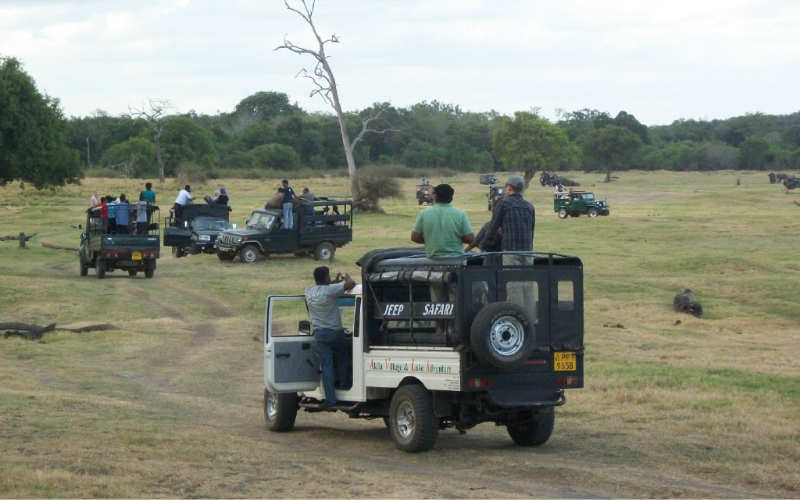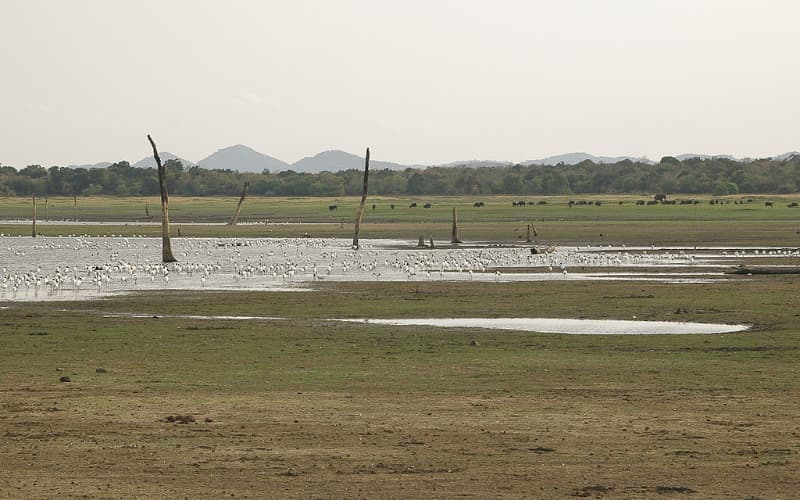Where is Minneriya National Park
Minneriya National Park is a national park in Sri Lanka’s North Central Province that is home to a variety of wildlife.
The area was first designated as a wildlife sanctuary in 1938, and it was only on August 12, 1997, that it was officially designated as a national park.
The area has been designated as a protected area in order to protect the catchment area of the Minneriya tank as well as the wildlife in the immediate vicinity.
The tank, which was constructed by King Mahasen in the third century AD, is significant in terms of history. For the elephant population that lives in the forests of Matale, Polonnaruwa, and Trincomalee districts during the dry season, the park serves as a winter feeding ground.
During the six-month period ending in August 2009, the park generated revenue of Rs. 10.7 million. Minneriya, together with Kaudulla and Girithale, is one of Sri Lanka’s Important Bird Areas (IBAs), which number 70 in total.
The park is located 182 kilometers (113 miles) away from the capital city of Colombo.
Best Time to Visit Minneriya National Park
March to October
Physical Features of Minneriya National Park
According to the National Weather Service, the area receives an average rainfall of 1,500–2,000 millimeters (59–79 inches) per year.
The lowest and highest temperatures recorded in the park are 20.6 degrees Celsius (69.1 degrees Fahrenheit) and 34.5 degrees Celsius (94.1 degrees Fahrenheit), respectively.
The tank receives its water primarily from a diversion of the Amban River and the Elahera canal system. The wet season is defined as the period from October to January when the northeastern monsoon rains and the dry season is defined as the period from May to September when the monsoon rains.
The primary habitats of Minneriya are diverse and include low-canopy montane forests, intermediate-to-high-canopy secondary forests, scrublands, abandoned chena lands, grasslands, rocky outcrops, and wetlands, among other types of vegetation.
The park’s primary habitats are diverse and include low-canopy montane forests, scrublands, grasslands, rocky outcrops, wetlands, and other types of vegetation.
Fauna
The faunal species found in the national park include 24 different species of mammals, 160 different species of birds, 9 different species of amphibians, 25 different species of reptiles, 26 different species of fish, and 75 different species of butterflies.
During the dry season, a large number of Sri Lankan elephants are drawn to the grass fields on the edges of the reservoir, where they can feed and rest.
The Minneriya tank contributes to the ability of a large herd to survive. The number of elephants gathered here is estimated to be between 150 and 200.
According to some reports, there are as many as 700 elephants in the world. They migrate here from Wasgamuwa National Park, where they can take advantage of the food and shelter provided by the park’s forest.
Tourists flock to Minneriya primarily for the opportunity to see elephants, especially during the dry season.
The park is an important habitat for the two endemic monkeys of Sri Lanka: the purple-faced langur and the toque macaque, both of which are found only in this country.
The park is home to large herbivorous mammals such as the Sri Lankan sambar deer and the Sri Lankan axis deer, as well as other species.
Minneriya is home to a number of rare and endangered species, including the Sri Lankan leopard and the Sri Lankan sloth bear. Minneriya is said to be one of the areas in Sri Lanka where the gray slender loris can be found, according to reports.
Water birds such as the lesser adjutant, painted stork, and spot-billed pelican find refuge in the Minneriya reservoir, which is an important breeding ground. Minneriya serves as a haven for a diverse range of resident and migratory bird species.
There have been reports of flocks of 2000 little cormorants. The great white pelican, ruddy turnstone, and grey heron are the other water birds that can be found here. Sri Lanka junglefowl, Sri Lanka hanging parrot, brown-capped babbler, Sri Lanka grey hornbill, black-crested bulbul, and crimson-fronted barbet are just a few of the endemic birds found in the country.
This national park has been home to 11 species of threatened birds, according to records.
Fejervarya pulla and Polypedates cruciger are two species of amphibians that have been found in the area. It is estimated that there are eight species of endemic reptiles in the world, and all of them are considered endangered.
Among these are the painted-lip lizard and the Lankascincus fallax. Among the other reptiles are the saltwater crocodile, the Indian python, the Asian water monitor, and the Bengal monitor. Four of the freshwater fishes found in Minneriya are endemic to Sri Lanka and cannot be found anywhere else in the world.
During the dry season, a large number of Sri Lankan elephants are drawn to the grass fields on the edges of the Minneriya reservoir. The park is an important habitat for the two endemic monkeys of Sri Lanka: the purple-faced langur and the toque macaque. Meneriya is home to a number of rare and endangered species. Sri Lankan leopards, sloth bears, and gray slender loris can be found in the area. Four of the freshwater fishes found in Minneriya are endemic to Sri Lanka.

Flora
Minneriya tank is surrounded by a variety of plants including Terminalia arjuna, Manilkara hexandra, Azadirachta indica, sacred fig (Ficus religiosa), and Piliostigma racemosum, all of which are native to Sri Lanka.
In Minneriya, the dominant plant species include Chloroxylon swietenia, Vitex altissima, Berrya cordifolia, Diospyros quaesita, and Drypetes sepiaria, among others. In abandoned chena cultivations and scrublands, the plants Randia dumetorum, crotons, and Calotropis gigantea can be found in abundance.
Throughout the park, visitors can see eucalyptus and teak plantations that were established by the Department of Forest Conservation.
Monocots and grasses such as Bambusa bambos, Ceylon date palm (Phoenix pusilla), Imperata cylindrica, and Panicum maximum are examples of monocot and grass species.
Minnneriya tank is surrounded by a variety of plants native to Sri Lanka. Throughout the park, visitors can see eucalyptus and teak plantations established by the Department of Forest Conservation. Monocots and grasses such as Bambusa bambos, Ceylon date palm (Phoenix pusilla) are examples of monocot and grass species.
Conclusion
After exploring the wonders of Minneriya National Park through the eyes of Ceylon Wild Tours, it’s clear that this national park is a must-visit destination for any nature lover or wildlife enthusiast. From the magnificent elephants to the stunning birdlife and the breathtaking scenery, Minneriya offers an unforgettable experience that showcases the incredible biodiversity and natural beauty of Sri Lanka.
The expert guides at Ceylon Wild Tours provide a unique perspective on this national park, making the trip even more memorable and informative. With their knowledge and passion for wildlife conservation, they create an experience that is not only enjoyable but also educational.
Whether you’re a first-time visitor or a seasoned traveler, Minneriya National Park is a place that will leave a lasting impression. The combination of wildlife, scenery, and knowledgeable guides makes it an ideal destination for anyone looking to connect with nature and experience the best that Sri Lanka has to offer.


11 thoughts on “Minneriya National Park | Sri Lanka”
Thanks for sharing. I read many of your blog posts, cool, your blog is very good.
Greetings from Idaho! I’m bored to tears at work so I decided to check out your website on my iphone during lunch break. I enjoy the knowledge you present here and can’t wait to take a look when I get home. I’m amazed at how quick your blog loaded on my cell phone .. I’m not even using WIFI, just 3G .. Anyhow, amazing site!
Spot on with this write-up, I truly assume this website wants rather more consideration. I抣l probably be again to read far more, thanks for that info.
I’m really enjoying the design and layout of your blog. It’s a very easy on the eyes which makes it much more enjoyable for me to come here and visit more often. Did you hire out a designer to create your theme? Great work!
I’m the designer and content writer for the site. Thanks a lot.
This design is steller! You most certainly know how to keep a reader amused. Between your wit and your videos, I was almost moved to start my own blog (well, almost…HaHa!) Great job. I really enjoyed what you had to say, and more than that, how you presented it. Too cool!
Have you ever considered publishing an ebook or guest authoring on other sites? I have a blog centered on the same information you discuss and would love to have you share some stories/information. I know my visitors would value your work. If you’re even remotely interested, feel free to send me an e-mail.
Greetings from Colorado! I’m bored to death at work so I decided to browse your site on my iphone during lunch break. I really like the knowledge you present here and can’t wait to take a look when I get home. I’m amazed at how quick your blog loaded on my phone .. I’m not even using WIFI, just 3G .. Anyways, superb blog!
I as well as my friends were analyzing the nice ideas from your site and unexpectedly I had a terrible feeling I never expressed respect to the web site owner for those techniques. My young men had been absolutely stimulated to read through them and now have sincerely been loving these things. Appreciation for simply being considerably kind and then for obtaining this sort of fabulous issues millions of individuals are really wanting to be aware of. Our sincere regret for not expressing gratitude to you sooner.
Hay,
Thanks for your time to write this up.
I believe honesty will be paid off and appreciated in due course. However, I do not expect anything out of my effort so even a small appreciation is enough for me to move on.
Hay…no worries. The world is still beautiful and nice people are still out there